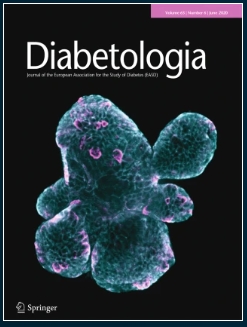Clinical utility of self-reported sleep duration and insomnia symptoms in type 2 diabetes prediction.
IF 10.2
1区 医学
Q1 ENDOCRINOLOGY & METABOLISM
引用次数: 0
Abstract
AIMS/HYPOTHESIS Suboptimal sleep health is linked to higher risks for incident type 2 diabetes. We aimed to assess the clinical utility of adding self-reported sleep traits to a type 2 diabetes prediction model. METHODS In this cohort study, we used UK Biobank data and Cox proportional hazards models to examine how self-reported sleep duration and insomnia symptoms were associated with incident type 2 diabetes risk. Harrell's C statistic and net reclassification improvement (NRI) were used to assess whether sleep traits improved the incident type 2 diabetes discrimination and predictive utility achieved using QDiabetes variables, with and without including a type 2 diabetes polygenic risk score (PGS). Independent replication was explored in the Nurses' Health Study, the Nurses' Health Study II and the Health Professionals Follow-up Study. RESULTS Extremes of sleep duration and occasional or frequent insomnia symptoms were associated with higher risks for incident type 2 diabetes. In the UK Biobank and replication cohorts, adding sleep traits to the QDiabetes risk score did not improve type 2 diabetes prediction (C statistic: QDiabetes alone 0.8933; QDiabetes + sleep duration 0.8939; QDiabetes + insomnia 0.8931; QDiabetes + sleep traits 0.8935). The corresponding total NRI values were: 0.08 (95% CI -0.18, 0.33), 0.04 (95% CI -0.08, 0.16) and 0.04 (95% CI -0.10, 0.18). Inclusion of PGS data marginally improved the type 2 diabetes risk prediction achieved using The QDiabetes calculator, with or without the inclusion of sleep traits in the model (QDiabetes + PGS: C statistic 0.8945; total NRI 0.20 [95% CI 0.12, 0.28]; QDiabetes + PGS + sleep traits: C statistic 0.8946; total NRI 0.18 [95% CI 0.09, 0.27]). CONCLUSIONS/INTERPRETATION While sleep duration and insomnia symptoms were associated with type 2 diabetes risk, they are not useful for improving type 2 diabetes prediction beyond QDiabetes model performance. Inclusion of a type 2 diabetes PGS marginally improved prediction but lacked clear clinical utility.自我报告睡眠时间和失眠症状在2型糖尿病预测中的临床应用
目的/假设不理想的睡眠健康与2型糖尿病发生的高风险有关。我们的目的是评估将自我报告的睡眠特征添加到2型糖尿病预测模型中的临床效用。方法在这项队列研究中,我们使用UK Biobank数据和Cox比例风险模型来研究自我报告的睡眠时间和失眠症状与2型糖尿病发生风险的关系。Harrell’s C统计量和净重分类改善(NRI)被用来评估睡眠特征是否改善了2型糖尿病的事件歧视和使用QDiabetes变量实现的预测效用,包括或不包括2型糖尿病多基因风险评分(PGS)。在护士健康研究、护士健康研究II和卫生专业人员随访研究中进行了独立的重复研究。结果:睡眠时间短、偶尔或频繁失眠与2型糖尿病发病风险增高相关。在英国生物银行和复制队列中,在QDiabetes风险评分中加入睡眠特征并没有提高2型糖尿病的预测(C统计值:QDiabetes单独为0.8933;QDiabetes +睡眠时间0.8939;糖尿病+失眠0.8931;糖尿病+睡眠特征0.8935)。相应的总NRI值分别为:0.08 (95% CI -0.18, 0.33)、0.04 (95% CI -0.08, 0.16)和0.04 (95% CI -0.10, 0.18)。无论是否在模型中纳入睡眠特征,纳入PGS数据都略微提高了使用QDiabetes计算器实现的2型糖尿病风险预测(QDiabetes + PGS: C统计量0.8945;总NRI 0.20 [95% CI 0.12, 0.28];QDiabetes + PGS +睡眠特征:C统计量0.8946;总NRI 0.18 [95% CI 0.09, 0.27])。结论/解释:虽然睡眠时间和失眠症状与2型糖尿病风险相关,但它们对于改善QDiabetes模型之外的2型糖尿病预测并无帮助。纳入2型糖尿病PGS略微提高了预测,但缺乏明确的临床应用。
本文章由计算机程序翻译,如有差异,请以英文原文为准。
求助全文
约1分钟内获得全文
求助全文
来源期刊

Diabetologia
医学-内分泌学与代谢
CiteScore
18.10
自引率
2.40%
发文量
193
审稿时长
1 months
期刊介绍:
Diabetologia, the authoritative journal dedicated to diabetes research, holds high visibility through society membership, libraries, and social media. As the official journal of the European Association for the Study of Diabetes, it is ranked in the top quartile of the 2019 JCR Impact Factors in the Endocrinology & Metabolism category. The journal boasts dedicated and expert editorial teams committed to supporting authors throughout the peer review process.
 求助内容:
求助内容: 应助结果提醒方式:
应助结果提醒方式:


